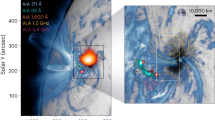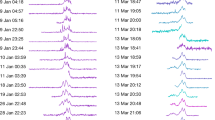Abstract
SINCE July 1958 the red oxygen (6300 A.) airglow has been recorded at Camden, near Sydney (geomagnetic latitude 42° S.), with a sky-scanning photometer. This instrument has been described by St. Amand1. These observations frequently detected greatly enhanced emission towards the south, and less often structures such as arcs and rays. We interpret these as auroræ, usually sub-visual, though on seven nights auroræ were seen.
This is a preview of subscription content, access via your institution
Access options
Subscribe to this journal
Receive 51 print issues and online access
$199.00 per year
only $3.90 per issue
Buy this article
- Purchase on Springer Link
- Instant access to full article PDF
Prices may be subject to local taxes which are calculated during checkout
Similar content being viewed by others
References
St. Amand, P., Ann. de Geophys., 11, 435 (1955).
Reber, G., and Ellis, G. R., J. Geo. Res., 61, 1 (1956).
Ellis, G. R., “Planetary and Space Science” (in the press).
Author information
Authors and Affiliations
Rights and permissions
About this article
Cite this article
DUNCAN, R., ELLIS, G. Simultaneous Occurrence of Sub-Visual Auroræ and Radio Noise Bursts on 4.6 kc./s.. Nature 183, 1618–1619 (1959). https://doi.org/10.1038/1831618a0
Issue Date:
DOI: https://doi.org/10.1038/1831618a0
This article is cited by
Comments
By submitting a comment you agree to abide by our Terms and Community Guidelines. If you find something abusive or that does not comply with our terms or guidelines please flag it as inappropriate.



